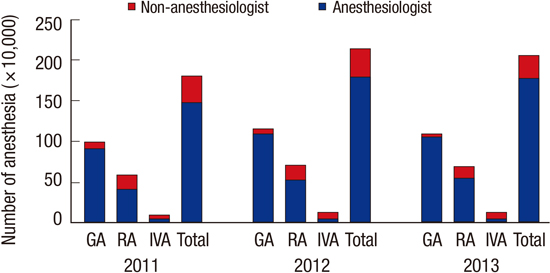1. Wong A. From the front lines: a qualitative study of anesthesiologists' work and professional values. Can J Anaesth. 2011; 58:108–117.
2. Agarwala AV, McCarty LK, Pian-Smith MC. Anesthesia quality and safety: advancing on a legacy of leadership. Anesthesiology. 2014; 120:253–256.
3. Roh WS, Kim DK, Jeon YH, Kim SH, Lee SC, Ko YK, Lee YC, Lee GH. Analysis of anesthesia-related medical disputes in the 2009-2014 period using the Korean Society of Anesthesiologists database. J Korean Med Sci. 2015; 30:207–213.
4. Hove LD, Steinmetz J, Christoffersen JK, Møller A, Nielsen J, Schmidt H. Analysis of deaths related to anesthesia in the period 1996-2004 from closed claims registered by the Danish Patient Insurance Association. Anesthesiology. 2007; 106:675–680.
5. Wacker J, Staender S. The role of the anesthesiologist in perioperative patient safety. Curr Opin Anaesthesiol. 2014; 27:649–656.
6. Hong SJ, Kang YJ, Jeon YH, Son JS, Song JH, Yoo CS, Kim DK. Analysis of expert consultation referrals to the Korean Society of Anesthesiologists (KSA): a comparison of procedural sedation and general anesthesia. J Anesth. 2013; 27:218–223.
8. Pearse RM, Dana EC, Lanigan CJ, Pook JA. Organisational failures in urgent and emergency surgery. A potential peri-operative risk factor. Anaesthesia. 2001; 56:684–689.
9. Silber JH, Kennedy SK, Even-Shoshan O, Chen W, Mosher RE, Showan AM, Longnecker DE. Anesthesiologist board certification and patient outcomes. Anesthesiology. 2002; 96:1044–1052.
10. Sury MR, Palmer JH, Cook TM, Pandit JJ. The state of UK anaesthesia: a survey of National Health Service activity in 2013. Br J Anaesth. 2014; 113:575–584.
11. Enright A. Review article: safety aspects of anesthesia in under-resourced locations. Can J Anaesth. 2013; 60:152–158.
12. Glenshaw M, Madzimbamuto FD. Anaesthesia associated mortality in a district hospital in Zimbabwe: 1994 to 2001. Cent Afr J Med. 2005; 51:39–44.
13. Hansen D, Gausi SC, Merikebu M. Anaesthesia in Malawi: complications and deaths. Trop Doct. 2000; 30:146–149.
14. Ouro-Bang'na Maman AF, Tomta K, Ahouangbévi S, Chobli M. Deaths associated with anaesthesia in Togo, West Africa. Trop Doct. 2005; 35:220–222.
15. Lee JJ, Lee NH, Park CM, Hong SJ, Kong MH, Lee KH, Yon JH, Song SO. Public awareness about the specialty of anesthesiology and the role of anesthesiologists: a national survey. Korean J Anesthesiol. 2014; 66:12–17.
17. Campbell G, Arfanis K, Smith AF. Distraction and interruption in anaesthetic practice. Br J Anaesth. 2012; 109:707–715.
18. Haller G, Stoelwinder J, Myles PS, McNeil J. Quality and safety indicators in anesthesia: a systematic review. Anesthesiology. 2009; 110:1158–1175.
19. Lee KH, An TH, Choi JH, Lim DG, Lee YJ, Kim DK. Analysis of expert consultation referrals for anesthesia-related issues (December 2008-July 2010): KSA legislation committee report. Korean J Anesthesiol. 2011; 60:260–265.
20. Merry AF, Cooper JB, Soyannwo O, Wilson IH, Eichhorn JH. International standards for a safe practice of anesthesia 2010. Can J Anaesth. 2010; 57:1027–1034.














 PDF
PDF ePub
ePub Citation
Citation Print
Print



 XML Download
XML Download